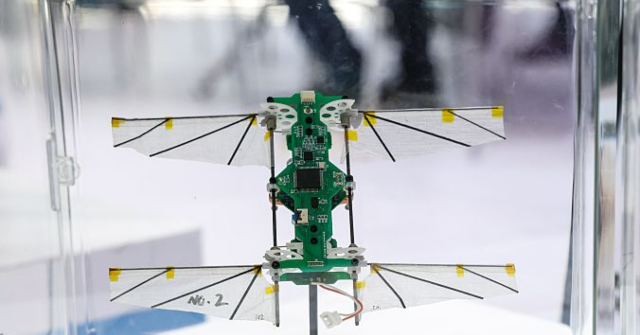Chinese state media reported on Friday that the National University of Defense Technology (NUDT) in Hunan has created a surveillance “microdrone” the size of a mosquito.
“Here in my hand is a mosquito-like type of robot. Miniature bionic robots like this one are especially suited to information reconnaissance and special missions on the battlefield,” NUDT student Liang Hexiang told the state-run China Central Television (CCTV).
The device Liang showed off had a stick-thin body, three hairlike “legs,” and tiny leaf-shaped wings. The report did not go into details about its range, endurance, control systems, or surveillance capabilities.
Drones that could be mistaken for insects are a holy grail for the fast-growing surveillance robot industry. The Wyss Institute at Harvard University unveiled its “RoboBee,” a microdrone with superficial similarities to China’s mosquito drone, in 2019.
RoboBee is allegedly about half the size of a paper clip, weighs a tenth of a gram, and flies by contracting tiny artificial “muscles “ with jolts of electricity. At present, the microdrone can only operate within the carefully controlled confines of its laboratory, but its developers hope it will someday be capable of navigating in the outside world with senses comparable to a real bee.
The designers of RoboBee hope the fully independent version of their creation could assist with environmental monitoring, search and rescue, and even pollination of crops, much as real bees do. Of course, it requires little imagination to see how microdrones could be weaponized for surveillance or assassination.
According to Chinese state media, the People’s Liberation Army (PLA) already has some drones that weigh less than a kilogram, fly in AI-controlled swarms, and can carry small explosives.
Under current definitions, a “microdrone” is any unmanned aerial vehicle (UAV) that weighs less than 250 grams (a little under 9 ounces).
Most existing microdrone designs are fairly slow because their tiny frames cannot carry engines that generate much thrust, but in May a student at the Chinese University of Hong Kong in Shenzhen set a world speed record with a palm-sized drone that flew at over 211 miles per hour.
The smallest drone currently employed by Western armed forces is the Black Hornet 4, a Norwegian design that looks like a palm-sized toy helicopter. The Black Hornet 4 boasts thermal imaging and low-light optics. It comes in a travel case that is small enough for soldiers to carry on their belts.
RoboBee and the Chinese mosquito drone are interesting, and perhaps unsettling, developments because they are not only incredibly small, but they fly by flapping their tiny wings instead of spinning rotors, which could make them quiet and difficult to spot on a chaotic battlefield. A swarm of such drones controlled by artificial intelligence could be a formidable surveillance asset, or even a weapon if the tiny devices were equipped with micro explosive charges or toxins.
Read the full article here
